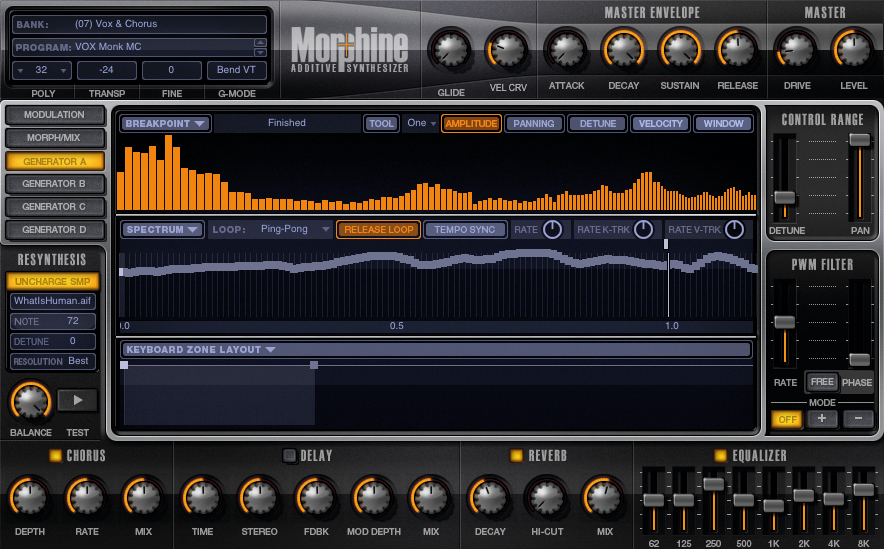MusicRadar Verdict
It's a tricky one to get right, the additive synth, but it seems that Morphine has been injected with Image-Line's famous usability formula. It sounds awesome too, so look no further for your additive fix.
Pros
- +
Brilliant, beautiful sounds. Fantastic presets. Not too difficult to learn. Noise samples add considerable interest. Resynthesis is a blast.
Cons
- -
Addictive is never going to be entirely easy.
MusicRadar's got your back
Programmer Maxx Claster is quickly becoming one of our favourites. We loved his previous solo offering, Toxic III, which we awarded 9/10 in cm103, and now he's weaving his magic in the service of those boffins from Belgium, Image-Line - they of FL Studio fame.
The result of Maxx's labours this time round is Morphine, a cross-platform synthesizer available in VST, AU and standalone incarnations.
Addition addicts What's so special about Morphine, then? Well, it would seem that the developers have rolled up a bona fide additive synthesizer with all of the trimmings.
'So what?' we hear you groan, and perhaps with good reason. There have been a handful of additive synthesizers released in recent years.
However, they often trade in the complexity of true additive synthesis for hybrid approaches that, while relatively easy to use, are not capable of the complex and realistic timbres of a 'pure' additive (for more details, see the Artificial additives boxout).
Overview
The designer of Morphine has found a solution that retains the depth and complexity of a fully additive instrument without giving up some semblance of user-friendliness. Mind you, user-friendliness is relative, and we don't mean to imply that first-time additive explorers won't be scratching their heads a little.
At first glance, it's obvious that Morphine bears little resemblance to the conventional subtractive synthesizers that most of us are used to. Gone are the simple, familiar oscillators we know so well, replaced here by a vast vista of vertical lines representing individual partials.
There are 128 partials per generator, and there are up to four generators per patch. Traditionally, a purely additive instrument would offer at least one pitch and amplitude envelope generator per partial. Morphine turns this idea on its head, offering what the developers call a Spectrum.
This is a sort of infinitely variable envelope generator. You can create as many breakpoints (nodes) as you like, and the amplitude, pan position and detuning values for all 128 partials are stored for each breakpoint.
This means that you can create timbres that change in an infinite variety of ways over time. While not quite as meticulous as having a separate envelope generator for each and every partial, it's still pretty flippin' flexible, and much less daunting.
While an additive instrument doesn't need filtering, Morphine offers a PWM Filter for each of the four generators. Based on pulse width modulation, the PWM Filter gives the tone a sort of hollow chorused or phased effect.
We found it worked quite well when modulated with an envelope generator from the Modulation page. While we're on the subject of envelopes, Morphine's Modulation page sports a quartet of them for twisting your timbres.
No simple ADSR affairs, you can add breakpoints to these suckers until your brains fall out. You can sync the envelopes to the host, and alter the playback rate in a number of ways, and you can also loop 'em up.
More modulation is offered on the Morph/Mix page. Here you'll find an X/Y pad for morphing between the four generators. This is akin to the vector synthesis seen on Arturia's Prophet V. Morphing is becoming an obligatory function of additive synthesizers, and it can certainly add some life to your patches.
Noise is decidedly difficult to re-create using additive synthesis. Morphine addresses the issue with a sample-playback section devoted to noise-based samples such as kick drum heads, castanets, surf and more.
There's a dedicated resonant filter for honing the selected noise sample to perfection. This is an unusual approach, but in practice it works a treat. Finally, there's the obligatory built-in effects processing. Chorus, delay, reverb and graphic EQ are offered.
They sound good and we're pleased to say that they've been put to tasteful use on the splendid factory presets. Re-re resynthesize The chore of working with additive synthesis can be made easier via the use of resynthesis, a technique where a sample is analysed and re-created using the instrument's partials, envelopes, etc. Morphine's resynthesis function is simple, to the point and reasonably effective.
Sounds
As always, successful results depend on the source material. Simple sounds with little noise and no reverb work best, but it can be good fun to throw something like a drum loop at the thing and see what comes out of it.
While native resynthesis isn't going to replace sampling altogether in the foreseeable future, it can still provide a wealth of interesting and intriguing sounds. No matter what we fed it, Morphine chewed it up gleefully, spitting back results that were often inspiring and always surprising.
By its very nature, additive synthesis is always going to be trickier to work with and less intuitive than, say, subtractive synthesis. Nevertheless, Image-Line and Maxx Claster have seen to it that it can still be quite a lot of fun.
Morphine is fairly easy and encouraging to use, thanks in no small part to the resynthesis engine. More importantly, the thing sounds absolutely beautiful. The preset designers have dished up an exquisite selection of engaging timbres, full of life and motion.
The emulated sounds are convincing and the pads are nothing short of breathtaking. This is what synthesis is supposed to be about. Summing it up We should note that while the listed system requirements are rather high, in reality, Morphine is fairly easy on your CPU, especially considering the gluttony of some similar products.
The asking price of $159 is fair, given the wealth of sounds it can create - this is a synth that will provide new sounds for many years to come, if you spend the time required to get your head around it.
Additive synthesis isn't going to be everyone's preferred poison, but for those who want to explore strange new sounds, Morphine is sure to be the perfect prescription. Nice work, guys.
Computer Music magazine is the world’s best selling publication dedicated solely to making great music with your Mac or PC computer. Each issue it brings its lucky readers the best in cutting-edge tutorials, need-to-know, expert software reviews and even all the tools you actually need to make great music today, courtesy of our legendary CM Plugin Suite.

“We finally buried the hatchet!!!”: 20 years after he accused her of miming and called her “a fairground stripper”, Elton John and Madonna are speaking to each other again

“I didn’t think people would mind that I didn’t play it, but it became a problem. I got myself into a pickle”: Clairo says it was Charli XCX who convinced her to perform one of her most popular songs again

“It pretty much half killed us. Whether the band would continue was very much in the balance”: The Radiohead album that almost broke up the band, turned the music industry on its head - and became their best record











